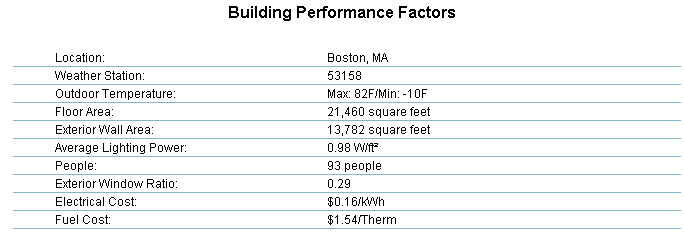When reviewing an Autodesk® 360 Energy Analysis in the Results and Compare dialog, this table summarizes the major factors that affect the energy consumption of the analyzed model. Weather-related factors include the location, weather station, and outdoor temperature.

Location
The project location, as specified in the Location Weather and Site dialog (which can be accessed from the Energy Settings dialog).
Weather Station
The weather station to be used for this project, as specified in the Location Weather and Site dialog (which can be accessed from the Energy Settings dialog).
Carbon-neutral design requires that you understand the weather data for the project location. Autodesk provides a complete year of hourly weather data, including dry-bulb temperature, dew point temperature, relative humidity, wind speed and wind direction, direct normal radiation, global and diffuse horizontal radiation, total sky cover, and more.
Many areas of the United States have micro-climatic conditions where the weather at an actual site may differ considerably from the nearest weather stations (typically located at the airport). Autodesk provides virtual weather stations no further than 14 km (8.8 miles) from a project virtually anywhere in the world.
The climate study portion of a design process should include, at a minimum, dry-bulb temperature and humidity studies and prevailing wind patterns for natural ventilation strategies.
Outdoor Temperature
The maximum and minimum temperatures at the project location.
Floor Area
The gross floor area of the analyzed model.
Exterior Wall Area
The net wall area (gross wall area, minus openings) of the analyzed model.
For single-family homes, heating and cooling loads are predominantly determined by the weather on the building envelope (skin). Internal loads (lighting, people, and equipment) play a smaller role.
For commercial projects, heating and cooling loads are driven by internal gains (heat emitted by people, lighting, and equipment) and by the building envelope. Depending on the building type and the exterior window ratio, HVAC loads may be more or less dependent on weather.
Average Lighting Power
The building-wide average of watts of lighting electricity per area of conditioned indoor space.
The default value applied to the analyzed model is based on minimum efficiency requirements for the ASHRAE 90.1 energy code. The default value varies by building type, such as schools or retail buildings.
People
The default value of occupancy density based on the ASHRAE 62 Standard for Ventilation and Acceptable Indoor Air Quality.
The occupancy density (number of people per area of occupied space) impacts energy usage of the analyzed model in 2 ways:
- The combined body heat of all people increases the cooling load and decreases the heating load.
- Ventilation rates are estimated based on occupancy density. Introducing outdoor air into the building is necessary for human comfort and health. Ventilation air, when supplied by mechanical systems, requires fan energy to circulate the air and heating and/or cooling energy to condition the air. The energy impact of changing the ventilation air quantity may be beneficial or detrimental depending on the building type, climate and time of year.
Exterior Window Ratio
The ratio of window area to gross wall area.
For more information, see Target Percentage Glazing.
Electrical Cost
Electrical costs are in U.S. dollars per kilowatt-hour (kWh). The rates are based on state-wide, territory-wide, or nation-wide average utility rates. The analysis uses flat rates, not time-of-use (TOU) rates, due to the complexity and variability of TOU rates for different regions and building sizes.
Fuel Cost
Fuel costs are in U.S. dollars per therm. They are based on state-wide, territory-wide, or nation-wide average utility rates.